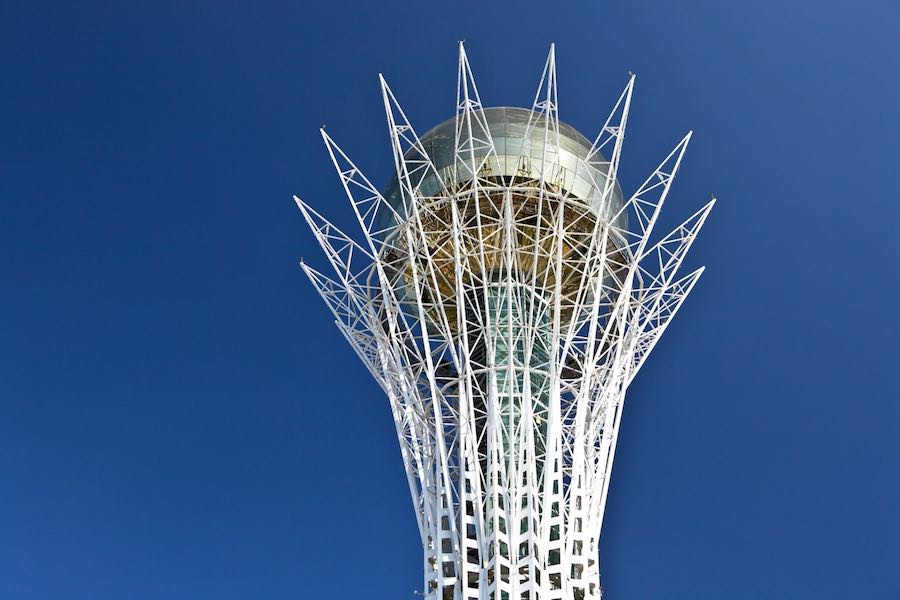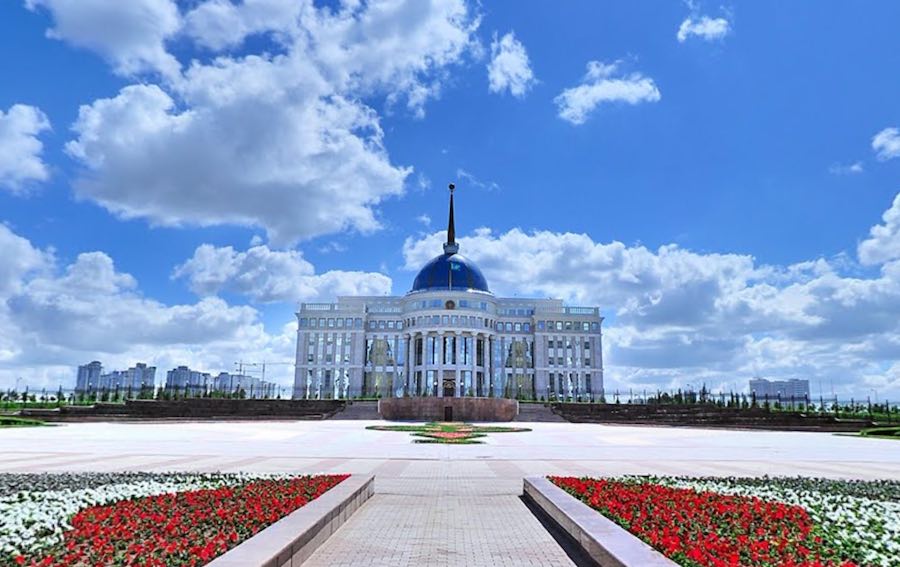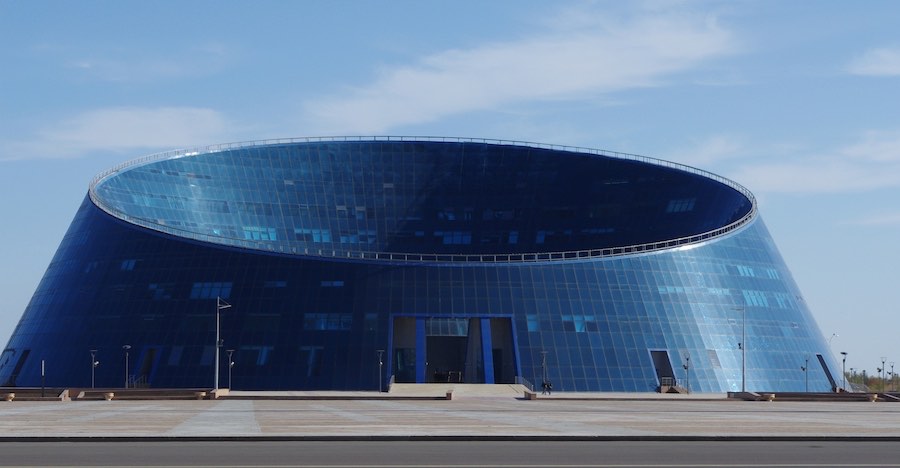Astana 2017 – Landing in Astana gives the impression of reaching an exact point in the middle of nowhere where dust and oil-money solidify in flamboyant architecture. Each building is designed to be a landmark shouting look at me. They come in odd shapes like beer cans and dog bowls, lollipops or cyclists’ helmets, while average streets have at least 8-10 lanes . Archipanic explored the wacky architecture of a city that celebrates it’s 20th birthday with the upcoming World Expo.
• RELATED STORIES: Read more about Astana 2017 Expo on Archipanic…
Astana – The Capital City in Kazakh – is designed to be blatantly big. It reflects the commitment of a new country trying to state its post-Soviet new identity – Hence, don’t rely too much on walking distances. At the same time, it offers all world class commodities, including also luxury treats an average petrol oligarch couldn’t do without. The best moment to get a glimpse of the city’s skyline is at sunset – the Golden Hour, according to locals – when skyscrapers glimmer above the surrounding steppe.
Astana Expo 2017
The 850.000 residents Eurasian rising metropolis was planned in 1997 by Metabolist Japanese architect Kisho Kurokawa. On June 10 until September 10, the city will host the World Expo. On this occasion, the oil country will try to reposition itself with a sustainable message focusing on future energies. Centred around a giant sphere, the brand new 173 hectare site master planned by Adrian Smith + Gordon Gill will function and live with renewable sources but will also provide energy to neighbouring districts. Watch video.
• RELATED STORIES: Read more about Kisho Kurokawa on Archipanic…
Bayterek Tower – the golden lollipop?
Originally envisioned by Kazakhstan president, the 105 m tall Bayterek Tower observation tower is Astana’s Tour Eiffel. The structure refers to a folktale about a mythical tree of life and a magic bird of happiness laying its egg on it. A 22 diameter golden sphere nested on top of a arboreal architecture hosts a panoramic view point 97 m above ground. It is said that Kazakhstan President Nursultan Nazarbayev came up with the idea for the tower and sketched it on a napkin. Visitors can go to the top of the tower to put their hand inside Mr. Nazarbayev’s gilded handprint. It is supposed bring good luck, they say…
Ak Orda
Parks and squares flanked by monumental buildings compose a mile-long perspective in the heart of the city framing the Ak Orda Presidential Palace. Completed in 2004, the palace hosts administration offices and gala halls for international events. On the top: a blue and gold dome with a spire and allegorical statures. Ak Orda might look little from a distance, but it is actually seven times the size of the White House. From here, Nursultan Nazarbayev rules the country since independence in 1991. The beloved president was recently confirmed with an eyebrow-rising 97,7% approval vote.
The Golden Towers – a.k.a. Beer Cans
Completed in 1998, two Golden Towers seem to guard the Ak Orda. The buildings are cladded in golden glass and steel and host governmental offices. Locals call them also “the Beer Cans”, for obvious reasons.
Khan Shatyr by Foster+Partners – The high-tech circus mall
In 2010, Foster+Partners completed this drunkenly leaning circus tent-looking mall housing major international brands. The Khan Shatyr hosts fashion boutiques and high-tech stores, food courts and even the artificial beach with sand imported from the Maldives. The building is wrapped by a quilted heat-absorbing material able to produce summer temperature even in the coldest months. Astana is the second coldest capital in the world – followed by Ulaan Baatar in Mongolia. Winter average temperature drops at -35 C° while summers reach +35 C°.
The Palace of Peace and Accord
Like Las Vegas, also Astana has a Parisian-style Pyramid. But instead of hosting a casino, the Fosters+Partners’ building was built to bring together world religious leaders to find common ground. Inaugurated in 2006, it contains accommodations for different religions: Judaism, Islam, Christianity, Buddhism, Hinduism, Daoism and other faiths. It also houses a 1.500-seat opera house, a national museum of culture and a new “university of civilization”.
The Nazarbayev Center
Completed by Foster+Partners in 2012, the Nazarbayev Center is the archive and library of the President of Kazakhstan hosting public event spaces, exhibition galleries and an auditorium. Its distinctive bowl-like form rises from the middle of a large formal landscaped garden, and is topped by a glass oculus spanning 90-metres. The building’s orientation and form is a response to the sun’s path to limit the direct sunlight onto the glazed roof.
Kazakhstan’s Central Concert Hall – a.k.a. The Blue Rose
Italian firm Studio Nicoletti Associati designed the Kazakhstan’s Central Concert Hall inspired by blooming rose petals as a metaphor of music. The building’s external structure comprises a series of curved, inclined walls made of concrete with a blue back painted glass panels cladding. These structures protect the building’s interior functions from Astana’s harsh weather conditions.
KazMunayGas Headquarters
KazMunayGas is a state-owned oil and gas company. Its giant headquarters building which sparkles at night with colorful lighting design and fountains is a clear reminder of the fact that, despite the Future Energy theme of Expo 2017, Kazakhstan’s economy still relies on traditional energy production.
Astana Palace of the Arts – A.k.a. the Dog Bowl
An other odd-shaped buildings is the Shabyt – Astana Palace of the Arts, a gigantic concave glass structure nicknamed the Dog Bowl. The building hosts a school of fine arts, lecture and exhibition halls, as well as performance spaces and a library.
Metropolitan Circus – a.k.a. The Spaceship
Astana Metropolitan Circus is the proof that aliens exist, as they parked their spaceship in Kabanbay Batyr 5. The building was then reconverted into a venue hosting events and gigs throughout the year.
The Cyclist Helmet, The Dollar Bill & other oddities
Astana velodrome comes in the shape of a racer’s helmet while the Ministry of Finance was inspired by a Dollar Bill… In Astana, can find all sort of architectural references, from a Chinese pagoda on top of a skyscraper to the Parthenon-looking opera house and the Triumph of Astana palace which was modeled after 1950s Stalinist high-rise architecture. Again, WELCOME to Astana!




















